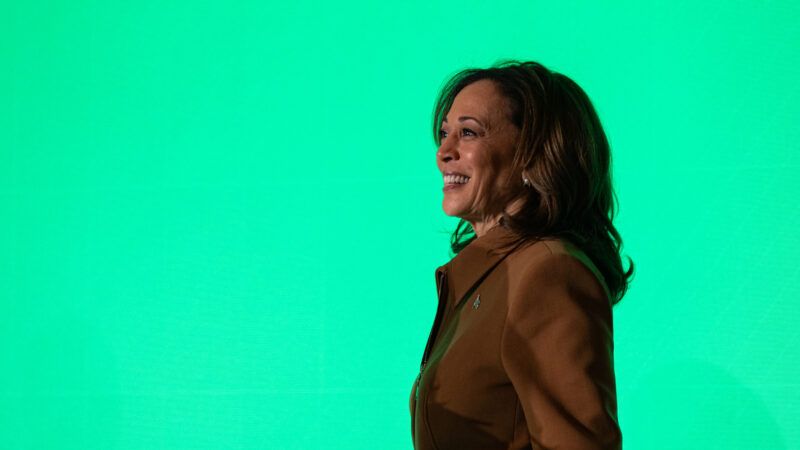Kamala Harris Pledges To Soak the Rich—But Her Policies Have Showered Them In Cash
Corporate subsidies and regressive tax breaks show who really benefits from Harris' agenda.

As the presidential race enters its final weeks, Vice President Kamala Harris is positioning herself as the champion of middle-class America, vowing to finally make the wealthy pay their fair share. Yet a closer look at her record over the past four years reveals a stark contrast between her rhetoric and reality. Far from soaking the rich, Harris' policies have funneled resources to the wealthy and corporations while burdening middle-class taxpayers.
Corporate subsidies have exploded under the Biden-Harris administration. In 2021, the 10-year budget allocation for corporate subsidies was $1.2 trillion. Three years later, it has now surpassed $2 trillion.
The 2022 CHIPS and Science Act included $54 billion in corporate subsidies—Intel alone received almost $20 billion in grants and loans through the CHIPS Act. The Inflation Reduction Act (IRA) uncapped a slew of energy subsidies, massively expanding energy production and investment tax credits, and according to the Brookings Institution, will cost an estimated $780 billion, just in corporate welfare, by 2031.
The beneficiaries of this largesse are extremely concentrated. Three-quarters of the benefits of the IRA are shared by just 15 large corporations, seven of which are foreign. Wind turbine manufacturers like General Electric, Vestas, and Siemens/Gamesa—who collectively produce 79 percent of all turbines—are among the biggest winners. These companies also have a presence on the board of the wind energy lobby, the American Clean Power Association.
But it isn't just the corporate welfare. The IRA's consumer subsidies also disproportionately benefit the wealthy. Roughly half of the tax subsidies for electric vehicles are largely captured by big corporations (Tesla, Ford Motor Co., General Motors), while almost four-fifths of taxpayers claiming these credits earn over $100,000 a year.
This administration has consistently pushed policies that favor higher-income Americans over lower- and middle-income Americans. The extended pause on student loan payments, which lasted until late 2022, primarily aided graduates who are lawyers and physicians—who make an average salary of $176,000 and $264,000, respectively—while being paid for by taxpayers, many of whom chose not to go to college.
For over two years now, the Biden-Harris administration has attempted, often unconstitutionally, to forgive $10,000 in student loan debt for some of the country's wealthiest workers. According to a Federal Reserve Bank of New York study, the larger the loan forgiveness, the more likely the beneficiaries will be white and wealthy. This is hardly a progressive policy.
Even the left has criticized student loan forgiveness. In fact, the editorial board of The Washington Post, as well as economist Jason Furman, who led the Council of Economic Advisers during the Obama administration, have pointed out that this policy is remarkably unfair and regressive.
Then there's the American Rescue Plan, the bill that helped spark the highest inflation in 40 years. It also expanded the Child Tax Credit (CTC) which, unlike income support programs, is not targeted towards low-income families. In 2019, families earning over $100,000 claimed 44 percent of all nonrefundable benefits, while only 11 percent went to families earning under $40,000. In his new book Taxocracy, Tax Foundation Senior Policy Adviser Scott Hodge points out that for taxpayers earning between $25,000 and $30,000, the average CTC received was $711, while taxpayers earning between $200,000 and $500,000 received $3,018 on average.
Now, Harris is proposing to not only restore the enhanced CTC, which was only in effect for one year in 2021, but to also create a new $6,000 tax credit for newborns. Vice presidential candidate J.D. Vance has floated a similar bad idea that is certain to redistribute yet more taxpayer funds to high-earning households.
Harris' policy agenda of feeding the rich was on full display at the Democratic National Convention in August, where Senate Majority Leader Chuck Schumer (D–N.Y.) openly urged to let the state and local tax (SALT) deduction cap expire in 2025. SALT allows taxpayers to deduct state and local income taxes (or, alternatively, sales taxes) and property taxes from their federal income tax liabilities. The SALT deduction is perhaps the most regressive provision in the tax code—99 percent of its benefits go to earners making over $100,000 a year, and 68 percent go to an even smaller group of earners making over $500,000 a year.
Despite Harris' rhetoric of fighting for the middle class, her policies have disproportionately benefited the wealthy and large corporations while leaving middle- and lower-income Americans behind. Far from soaking the rich, Harris' legacy has been one of feeding them.


Show Comments (38)